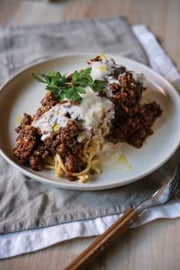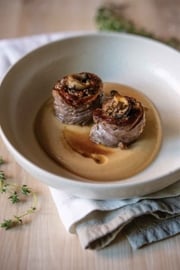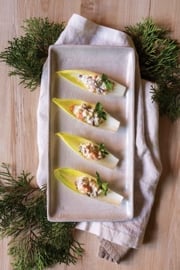
If you’re going to serve a salad as a main dish, it had better impress. As a celebration of enticing textures and awakening flavours, this one certainly does just that. You can use one type of microgreen for the pesto (try basil, mustard, kale, or radish) and another for the salad, such as sunflower, red cabbage, pea shoots, or arugula.
Dark delight
Named after the whale caviar they resemble, black (beluga) lentils are worth seeking out. They are less earthy-tasting than other lentils and hold their shape once cooked, making them a stand-out addition to salads.
Tip: Leftover pesto is exceptional as a sandwich spread or stirred into a pot of cooked pasta. Wild salmon or Arctic char would be two nutritious and sustainable alternatives to trout.
Trout Lentil Salad with Microgreen Pesto Dressing
Ingredients
- 2/3 cup (160 mL) black (beluga) lentils
- Pinch of salt
- 1 lb (450 g) rainbow trout fillets
- 4 cups (1 L) microgreens, divided
- 2 garlic cloves, minced
- 1/4 cup (60 mL) hemp hearts
- Juice of 1/2 lemon
- 1/3 cup (80 mL) grated Parmesan cheese
- 1/4 cup (60 mL) + 2 Tbsp (30 mL) extra-virgin olive oil or camelina oil
- 8 cups (2 L) salad greens
- 1 cucumber, chopped
- 1/3 cup (80 mL) sliced oil-packed sundried tomatoes
- 2 green onions, sliced
- 2 Tbsp (30 mL) unsalted shelled pistachios
- 2 Tbsp (30 mL) drained capers
Nutrition
Per serving:
- calories577
- protein43g
- fat29g
- saturated fat5g
- trans fat0g
- carbohydrates38g
- sugars5g
- fibre16g
- sodium599mg
Directions
01
Place lentils, 3 cups (750 mL) water, and salt in medium-sized saucepan. Bring to a boil, reduce heat to medium-low, and simmer until lentils are tender but not mushy, about 25 minutes. Drain and set aside.
02
Meanwhile, heat oven to 400 F (200 C). Season trout with salt and place on parchment paper-lined baking sheet. Bake until trout is just cooked through in centre, about 12 minutes. Let cool for a few minutes and then gently break apart flesh with fork.
03
To make microgreen pesto, in food processor, pulse together 2 cups (500 mL) microgreens, garlic, hemp hearts, and lemon juice until well combined. Add Parmesan and then drizzle in 1/4 cup (60 mL) oil through the top feed tube with machine running. To make vinaigrette, whisk together 3 Tbsp (45 mL) pesto, 2 Tbsp (30 mL) oil, 1 Tbsp (15 mL) water, and a couple pinches of salt.
04
To assemble salad, divide salad greens, lentils, cucumber, sundried tomatoes, green onions, pistachios, and capers among serving plates. Top with trout and 2 cups (500 mL) microgreens. Drizzle on microgreen dressing.





